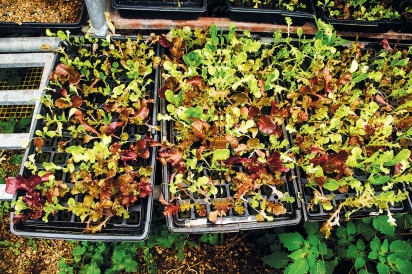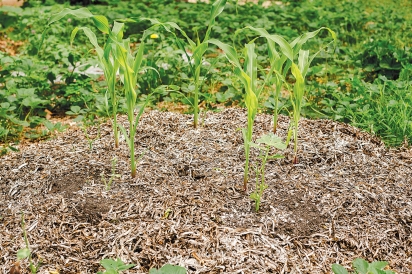Winter Gardening
With a relatively short growing season here on the Cape, local gardeners want to maximize it as much as possible. So when is it time to start thinking about the garden for the next season, and what can be done during the winter months?
As outside temperatures drop below freezing, the top layer of soil, called the frost layer, freezes due to its water content. The thickness of the frost layer varies depending on temperatures, moisture content and whether the soil is insulated by an early layer of snow or organic matter such as mulch, leaves or compost. Native perennial plants survive the winter freeze by growing deep roots that extend below the frost layer and by releasing excess water from stems and roots to prevent freezing and expanding from within. Soil microbes also survive the winter months both by going below the frost layer and by going dormant in frozen soil.
Outdoor potted plants rarely survive the winter without help, but larger pots with larger volumes of soil do better, and pots can be wrapped in burlap and straw and placed in a protected, unheated place such as under a porch or in the garage for shelter from the elements.
Ron Smolowitz of Coonamessett Farm in East Falmouth suggests removing dead plants and crop waste from the garden at the end of the growing season. “You don’t want to let the dead plants be there because they’ll harbor diseases and pathogens, so you pull them out and you can compost them, but don’t just leave them there in the garden.”
As the farmer of a 12-acre farm, Smolowitz notes the differences between commercial farms and the backyard gardener as being significant, but many of his tips are universal. He advises to use the winter months to fix equipment and buildings and also reminds us that turning the compost pile is important throughout the winter.
One of the major distinctions that Smolowitz makes between home gardeners and larger farms is whether one tills. At Coonamessett Farm they remove the remnants of a crop from a field at the end of the growing season, and then till the field and let it lie dormant until weeds begin to sprout. Then a cover crop of winter rye or oats (they sometimes also use peas or hairy vetch as cover crops) is planted and then tilled lightly again to incorporate the seed and kill the weeds. Much like weeds, some cover crops, including winter rye, survive the winter while others do not. Smolowitz also reminds us not to let a cover crop go to seed unless you want it to reseed itself. “I let the rye put on some spring growth in March and April, then as I start to plant lettuce in April I’ll till where I’m planting. If you let it get too tall you can mow it so it doesn’t become a problem when you’re ready to till it,” he says.
Smolowitz says he wouldn’t bother with cover crops if he didn’t own a tiller. “When I had a small raised bed garden I just covered the beds with seaweed. There’s a French method where you have a raised bed without a side; you dig walkways and then pile the dirt up on the raised bed. You fill the walkways with seaweed and after a year you turn one onto the other during the winter, so you’re flipping your beds and getting that organic matter into the soil. But even if you’re covering it with compost, come the spring you’ve got to work it into the soil.” He suggests finding and stockpiling seaweed ahead of time if you have room, or at least rinsing it before putting it on your beds to avoid adding too much salt to your garden.
Anne Richards, a Falmouth home gardener, calls her method “composting in place.” She piles about twelve inches of leaves on her garden beds in the fall. She tries to spread them before a rain and not on windy days to prevent them blowing off into a neighbor’s yard. She likes to use maples and black locust on the beds, and oaks in the paths, as oaks are very waxy and don’t break down as quickly. By spring the leaves have settled to around half their original height.
“If it’s seedlings I’m planting, I make a hole in the leaves, put in a scoop of compost and plant the seedling in the compost. If I’m planting seeds, I pull aside leaves to make a row, add some compost and plant the seeds in the compost. The leaves provide a nice layer of mulch, and by the end of the growing season, they have composted down to just a thin layer, below which there is a nice thick layer of worm castings. I never have to weed!”
Richards has been using this method since 2009, when she was inspired by the “no-work” gardening techniques of Ruth Stout. She watched a YouTube video about the inspiring gardener over the holidays that year, and she was out in her own garden on New Year’s Day starting her first leaf beds. Richards notes that the leaves do provide a good environment for hungry pests to hide and eat her spring seedlings. She hand picks the slugs after dark and this year she raised some toads from eggs that she hopes will move into her garden and help with pest control.
Richards occasionally spreads wood ash on her beds during the winter and says, “I think it would be good to grow some cover crops, because I suspect leaves are not diverse enough to supply all the nutrient needs. But I’ve gotten away without adding fertilizer for years now, and I have definitely got a lot more diverse insect life out there after years of doing this, which is very fun to watch and good for keeping the ‘bad’ bugs down.”
Smolowitz used to add lime to his gardens during the off season, “but with all the organic matter the pH of our soil seems to be stable, so we haven’t limed in years.” His compost includes bedding and manure from his various farm animals and he adds leaves to the pile in the late winter and early spring. As a commercial farmer, he composts everything before adding it to the garden.
The winter months are also a good time to start planning your garden for the coming year and looking through seed catalogues. Smolowitz saves completely dry seeds from particularly productive plants in plastic ziplock bags in a cool dry place. He refrigerates certain flower seeds and other seeds with low germination rates, but most seeds don’t need refrigeration and can handle some temperature fluctuation.
Smolowitz grows plants in the six greenhouses on Coonemessett Farm throughout the year. He utilizes hydroponics along with other methods for indoor growing. He starts some spring crops indoors from plugs and others from direct seed, and some continue to be transplanted and grown in the greenhouse, while others are ultimately planted in the ground outdoors. He says that starting with plugs (seedlings) of eggplants, peppers and tomatoes saves a month of heating the greenhouse, compared with if he plants and germinats the seeds himself. Richards also starts a lot of her seedlings indoors and has access to a greenhouse at her work, but someone without greenhouse access could start seedlings in their home and transplant the plants outdoors after the last frost.
If you don’t have any kind of hoop house or greenhouse setup, then keep your seedlings safely indoors until after the last frost. If starting seedlings in your home, avoid starting them too early because you will have to keep transplanting them into larger pots as they grow, and they may start to take up too much space or become root bound or malnourished in too small a pot before it’s time to plant them outside around early to mid May. Some people use spring blossoms such as lilacs, apples or dogwoods as an indication that it is safe to plant outside, but these days the weather is ever less predictable, so use your best judgment. You can also save a few seedlings indoors to be safe. Most vegetable seeds should be planted between two weeks and two months prior to when you intend to plant them outdoors. Cape Cod Cooperative Extension’s website offers some useful fact sheets and resources for gardeners to help determine when to plant specific crops.








